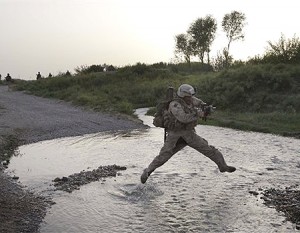Force Protection in Operation Khanjar
BY Herschel SmithA very good report from Matt Sanchez.
It’s the middle of the night at the east corner guard post of Fiddler’s Green, a Marine fire base in Afghanistan’s Helmand Province, along the border with Pakistan.
Corporal Ryan Joseph Bernal is on perimeter security duty.
Armed with an M-4, night vision binoculars and an array of high-powered automatic weaponry, the 22-year-old U.S. Marine and several others keep watch for activity just outside the concertina wire, which conveys the powerful message “DO NOT ENTER” in a universal language Marines, civilians and the Taliban all understand …
A tiny red flare warns potential intruders not to approach — but it’s the figures you can’t see who pose the greatest threat to Fiddler’s Green, located at what commanders call a “chokepoint to Taliban activity.”
Throughout the day, redundant checks are designed to account for Marines. “Accountability. Eyes on every Marine, pre-combat checks, pre-combat inspections,” said battalion commander Lt. Chris Lewis. “Physical and visual accountability, nothing less.”
Based upon what I know from Operation Alljah, I have always rejected the dichotomy between force protection and force projection, or between U.S. troop security and population security, no matter what the in vogue “population-centric COIN” doctrine says. The Marines are in touch with the population during constant patrols – patrols so intense and long that many are suffering dehydration because they can’t carry enough water. There is no need to make themselves insecure during sleep in order to win the cooperation of the population, no matter what a counterinsurgency field manual says. It didn’t work that way in the Anbar Province of Iraq.
One other report to drive home the point from the Washington Post.
Two Marines on a road-clearing crew were killed Monday in Helmand’s Garmsir District, after they traced the wire of a suspected bomb into a house that was rigged to explode, according to an officer with their unit. Since the U.S. launched its Helmand operation, Western troops in Afghanistan have been dying at a rate of three a day, far higher than the normal rate.
The bomb attacks have slowed or obstructed the Marines’ use of the network of narrow, unpaved dirt roads that link farming villages in the river valley. The bombs have already disabled several vehicles which are further hampered by their bulk in navigating the primitive roads. The Marines’ mine-resistant armored protection vehicles “are just too big for those roads,” said Col. Eric Mellinger, operations officer for the Marine
brigade.Commanders have made some roads off limits, instead requiring slow-going travel through adjacent deserts, or foot marches through fields and canals. Many of the supplies for the troops are being flown in by helicopter.
If, at the present time, the force presence isn’t enough to fully secure the physical terrain and thus IEDs remain a serious threat on the roads, then adapt. It’s what Marines do. Stick to the deserts, trenches and untraveled areas. Slower, sure. But do you think the Marines will be exposed to the population and meet some Afghanis during these treks? And do you think the Taliban have the manpower or ordnance to mine the entire countryside with IEDs because of this adaptation, or will they get frustrated?
Postscript: Is “Fiddler’s Green” a cool name for a fire base, or what? I want to go there.






On July 17, 2009 at 10:17 am, Warbucks said:
They might find and entrap more Taliban if they named it “Fiddler on the Roof”… or not.